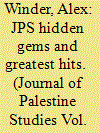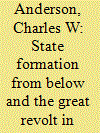| Srl | Item |
| 1 |
ID:
178336


|
|
|
|
|
| Summary/Abstract |
Perusing JPS’s fifty years of documenting Palestinian history, this essay reminds us that history is both “what happened” as well as “the narration of what happened.” Anchoring his selection in that perspective, Alex Winder identifies Charles Anderson’s “State Formation from Below and the Great Revolt in Palestine” (2017) as a JPS “hidden gem,” and Tarif Khalidi’s “Palestinian Historiography: 1900–1948” (1981) as a “greatest hit.” Relying on primary sources by participants in the rebellion and highlighting the history of the revolt, Anderson shifts the focus of traditional accounts of the revolt from the mostly ineffective role of Palestinian notables and elites to the successes of the rebels. In a similar vein, Khalidi’s article paints a picture of a rich and vibrant Palestinian intellectual life in the first half of the twentieth century that reverses the conventional view of the colonized as reactive and of the colonizer as the primary agent of history.
|
|
|
|
|
|
|
|
|
|
|
|
|
|
|
|
| 2 |
ID:
155908


|
|
|
|
|
| Summary/Abstract |
The Great Revolt (1936–39) represented the most fervent and sustained Palestinian challenge to British and Zionist colonialisms during the thirty years of British rule in Palestine. Although its ultimate defeat has led to negative appraisals of its historical significance, the uprising was in its day the largest mass mobilization in Palestinian history and, at its apex, threatened to overturn the British regime. The rebellion was characterized by considerable organizational ingenuity as Palestinians created novel institutions that embodied their drive for popular sovereignty and an end to colonial domination. This article principally examines two such sets of institutions, the national and popular committees of 1936, and the rebel court system from 1937–39. In doing so, it argues that much like revolutionary peasant-based movements elsewhere in the colonial world, insurgent forces in Palestine embarked on a process of state formation from below. This process aimed to sap the colonial regime of its authority and weaken its capacities while augmenting those of the rebels by integrating broad segments of the population into insurgent frameworks. It further contends that it is the dynamic of state formation from below, and the popular character and leadership of the rebel movement, that lent the revolt its resilience and enabled it to push the colonial state to the wall.
|
|
|
|
|
|
|
|
|
|
|
|
|
|
|
|